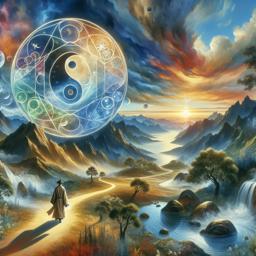
Map vs. Territory: Understanding Conceptual Maps in Taoist Practice
In the realm of Taoist philosophy and practice, the distinction between the map and the territory is a critical concept that invites deeper exploration and understanding. This idea underscores the importance of using conceptual maps as guides for practice while recognizing that they are not substitutes for direct experience.
The Conceptual Map
Conceptual maps are frameworks that help practitioners navigate the complexities of Taoist philosophy and practices. One such map is the Bagua:
- Bagua: A symbolic representation rooted in the I Ching (Book of Changes), consisting of eight trigrams.
- Each trigram holds a distinct symbolic meaning and is associated with natural elements.
- The trigrams are used to interpret underlying patterns and dynamics in both the cosmos and human life.
These maps provide valuable insights and guidelines:
- Structure: They offer a structured way to understand complex principles.
- Guidance: They serve as tools to guide meditation, practices, and personal growth.
- Interpretation: They help practitioners interpret the interconnections between various aspects of life.
The Territory: Direct Experience
While conceptual maps like the Bagua are invaluable, they are not ends in themselves:
- A map is not the territory it represents—it is a simplified depiction.
- Direct, personal experience is crucial for true understanding and growth in Taoist practice.
- Engaging with reality without preconceived notions allows for a deeper connection with the Tao.
The Balance Between Map and Territory
- Integration: Use maps as guides, integrating their insights with personal experiences.
- Flexibility: Maintain openness to where the path leads beyond the map's scope.
- Adaptation: Modify approaches as necessary, based on your evolving understanding and experiences.
Applying the Distinction in Practice
To harmonize the map-territory relationship:
- Study: Engage with conceptual maps like the Bagua to grasp foundational knowledge.
- Reflect: Contemplate the teachings to internalize their significance in the broader tapestry of your life.
- Experience: Immerse yourself in direct experiences; allow them to shape your interpretations and practices.
- Discern: Approach each new experience with discernment, differentiating between helpful structures and rigid frameworks that may limit understanding.
Conclusion
In Taoism, understanding the difference between the map and the territory encourages a practice enriched by both tradition and personal insight. While conceptual maps like the Bagua offer structured guidance, it is through the courage to experience directly and openly that one can truly walk the path of the Tao. Embrace both the wisdom of the ancients and the vitality of the present, where every step on the journey is as significant as the destination.
- taoism
- bagua
- i ching
- conceptual maps
- direct experience